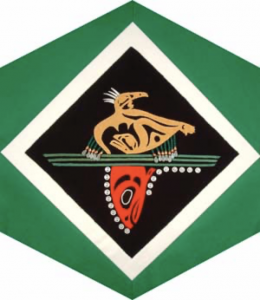Gitxsan

The Block
This block was created by Valerie Morgan, whose Gitxsan-language name is Stem gem gi pikxw. Valerie’s husband Ken, a Native artist and carver, assisted in its design using traditional “methods, colours and materials passed down from the grandparents.” Backed by navy cashmere wool, a Welcome Dancer with Raven headdress and Frog cape is appliquéd in tan moose hide. Turquoise leather strips depict water and a red Spring Salmon is outlined in white buttons symbolizing fish eggs. Treasured heirloom dentallium shells decorate the headdress, while twelve fringes on the cape include matte teal beads, iridescent teardrop beads, and copper bugles that represent the historic shields of Gitxsan warriors.
Cultural Profile
Since time immemorial, rugged Mount Rocher de Boule and the Seven Sisters Mountain Range have stood like sentinels of the Gitxsan people along northwestern British Columbia’s Skeena and Bulkley rivers. 70 percent of the Gitxsan Nation live in the traditional territories in five villages (Gitwangak, Gitsegukla, Gitanmaax, Glen Vowell, Kispiox) and the two provincial municipalities of Hazelton and New Hazelton. This largely youthful population exhibits a strong cultural vitality. The Gitxsan language is Tsimshianic.
Each spring when the Skeena River swells, the Gitsxan ready themselves for the returning salmon. As the river recedes, the Salmon People (a race of people from the sea) begin their journey upriver to spawn. In the villages, the ritual of the First Salmon is performed with welcome dances, feasting and the return of complete salmon bones to the river. These traditions guarantee abundant salmon harvests for generations to come. Salmon has long been the mainstay of the Gitxsan people, who developed many fishing methods, including traps, fences, spearing, weirs, and dip nets. When the salmon population dwindled each fall, the people honed their hunting and trapping skills on the Pine Marten, Wolverine, Mountain Goat, Black Bear and Marmot.
Gitxsan oral histories, or adwaak, date back ten thousand years and validate the people’s connection to the land. In recent decades they have been on a journey of gathering these histories from the elders, resulting in an archival collection of cultural identity that includes over ten thousand items. These histories, legends and folklore provide invaluable information about genealogy and historical changes affecting weather patterns, local geology, and wildlife. The Gitxsan did not simply occupy their traditional territories; they were a part of the land.
Sponsor: Andrew Thomson, in memoriam Margaret and Andrew Thomson
